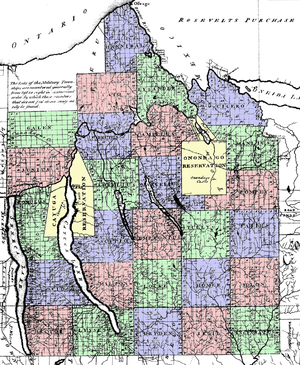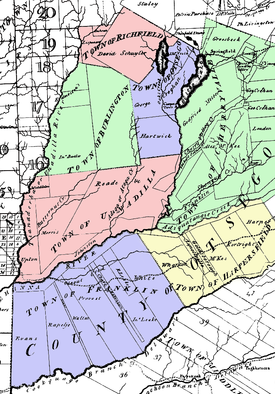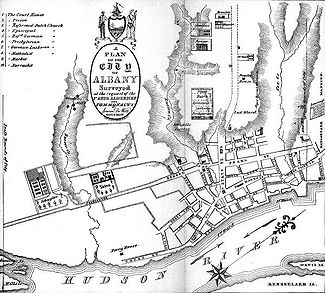
Simeon De Witt
Encyclopedia
Simeon De Witt was Geographer and Surveyor General of the Continental Army
during the American Revolution
and Surveyor General of the State of New York
for the fifty years from 1784 until his death.
Dr. Andries De Witt and Jannetje Vernooy De Witt. He was the only graduate in the class of 1776 at Queens College (now Rutgers College of Rutgers University
in New Brunswick, New Jersey
. After the capture of New Brunswick by the British
during the war, De Witt fled to New York City
where he joined the Revolutionary Army.
In June 1778, having been trained as a surveyor by James Clinton
, the husband of Simeon's aunt Mary, De Witt was appointed as assistant to the Geographer and Surveyor of the Army Colonel
Robert Erskine
and contributed to a number of historically significant maps. After Erskine's death in 1780, De Witt was appointed to his post. In 1784, he was appointed New York State Surveyor General
and died in office 50 years later, having been re-appointed and re-elected several times. Although he was a first cousin
of DeWitt Clinton
and a Democratic-Republican, he was never removed from office. Both Federalists and Bucktails
recognized his outstanding qualification for the office. From 1810 to 1816, he was also a member of the first Erie Canal Commission
.
De Witt was married three times. In 1789, he married Elizabeth Lynott (1767-1793, daughter of Thomas and Elizabeth Van Valkenburgh Lynott), and they had two children. In 1799, he married Jane Varick Hardenbergh (d. 1808, widow of Abraham Hardenbergh [1756-1794], and sister of Richard Varick
), and their son, Richard Varick De Witt, became a prominent civil engineer
. Later, Simeon married Susan Linn.
De Witt held four slaves at his residence in Albany, New York
but by 1810 he had freed them, a common practice of the area. They continued to work in his household. He owned a considerable amount of land in the Finger Lakes
area and is considered one of the founders of Ithaca, New York
. He was often given credit for giving Classical antiquity
Greek and Roman names to the twenty-eight central New York Military Tract
townships
that his office mapped after the war (to be given to veterans in payment for their military service). More recently, credit has been given to his clerk Robert Harpur
, apparently a reader of classical literature (Lemak 2008:245).
Continental Army
The Continental Army was formed after the outbreak of the American Revolutionary War by the colonies that became the United States of America. Established by a resolution of the Continental Congress on June 14, 1775, it was created to coordinate the military efforts of the Thirteen Colonies in...
during the American Revolution
American Revolution
The American Revolution was the political upheaval during the last half of the 18th century in which thirteen colonies in North America joined together to break free from the British Empire, combining to become the United States of America...
and Surveyor General of the State of New York
New York State Engineer and Surveyor
The New York State Engineer and Surveyor was a state cabinet officer in the State of New York between 1848 and 1926. During the re-organization of the state government under Governor Al Smith, the office was abolished and its responsibilities transferred to the Department of Public Works which was...
for the fifty years from 1784 until his death.
Life
He was one of fourteen children of physicianPhysician
A physician is a health care provider who practices the profession of medicine, which is concerned with promoting, maintaining or restoring human health through the study, diagnosis, and treatment of disease, injury and other physical and mental impairments...
Dr. Andries De Witt and Jannetje Vernooy De Witt. He was the only graduate in the class of 1776 at Queens College (now Rutgers College of Rutgers University
Rutgers University
Rutgers, The State University of New Jersey , is the largest institution for higher education in New Jersey, United States. It was originally chartered as Queen's College in 1766. It is the eighth-oldest college in the United States and one of the nine Colonial colleges founded before the American...
in New Brunswick, New Jersey
New Brunswick, New Jersey
New Brunswick is a city in Middlesex County, New Jersey, USA. It is the county seat and the home of Rutgers University. The city is located on the Northeast Corridor rail line, southwest of Manhattan, on the southern bank of the Raritan River. At the 2010 United States Census, the population of...
. After the capture of New Brunswick by the British
Kingdom of Great Britain
The former Kingdom of Great Britain, sometimes described as the 'United Kingdom of Great Britain', That the Two Kingdoms of Scotland and England, shall upon the 1st May next ensuing the date hereof, and forever after, be United into One Kingdom by the Name of GREAT BRITAIN. was a sovereign...
during the war, De Witt fled to New York City
New York City
New York is the most populous city in the United States and the center of the New York Metropolitan Area, one of the most populous metropolitan areas in the world. New York exerts a significant impact upon global commerce, finance, media, art, fashion, research, technology, education, and...
where he joined the Revolutionary Army.
In June 1778, having been trained as a surveyor by James Clinton
James Clinton
James Clinton was an American Revolutionary War soldier who obtained the rank of major general.He was born in Ulster County in the colony of New York, in a location now part of Orange County, New York...
, the husband of Simeon's aunt Mary, De Witt was appointed as assistant to the Geographer and Surveyor of the Army Colonel
Colonel
Colonel , abbreviated Col or COL, is a military rank of a senior commissioned officer. It or a corresponding rank exists in most armies and in many air forces; the naval equivalent rank is generally "Captain". It is also used in some police forces and other paramilitary rank structures...
Robert Erskine
Robert Erskine
Colonel Robert Erskine was a Scottish inventor and later an American officer in the Continental Army during the American Revolutionary War....
and contributed to a number of historically significant maps. After Erskine's death in 1780, De Witt was appointed to his post. In 1784, he was appointed New York State Surveyor General
New York State Engineer and Surveyor
The New York State Engineer and Surveyor was a state cabinet officer in the State of New York between 1848 and 1926. During the re-organization of the state government under Governor Al Smith, the office was abolished and its responsibilities transferred to the Department of Public Works which was...
and died in office 50 years later, having been re-appointed and re-elected several times. Although he was a first cousin
Cousin
In kinship terminology, a cousin is a relative with whom one shares one or more common ancestors. The term is rarely used when referring to a relative in one's immediate family where there is a more specific term . The term "blood relative" can be used synonymously and establishes the existence of...
of DeWitt Clinton
DeWitt Clinton
DeWitt Clinton was an early American politician and naturalist who served as United States Senator and the sixth Governor of New York. In this last capacity he was largely responsible for the construction of the Erie Canal...
and a Democratic-Republican, he was never removed from office. Both Federalists and Bucktails
Bucktails
The Bucktails may refer to one of two organizations that were particularly characterized and identified by the wearing of a bucktail in their headgear....
recognized his outstanding qualification for the office. From 1810 to 1816, he was also a member of the first Erie Canal Commission
Erie Canal Commission
The New York State Legislature appointed in 1810 a Commission to Explore a Route for a Canal to Lake Erie, and Report which became known as the Erie Canal Commission...
.
De Witt was married three times. In 1789, he married Elizabeth Lynott (1767-1793, daughter of Thomas and Elizabeth Van Valkenburgh Lynott), and they had two children. In 1799, he married Jane Varick Hardenbergh (d. 1808, widow of Abraham Hardenbergh [1756-1794], and sister of Richard Varick
Richard Varick
Richard Varick was an American lawyer and politician. He was born on 15 March 1753 at Hackensack in Bergen County, New Jersey, and he died on 30 July 1831 at Jersey City in Hudson County, New Jersey....
), and their son, Richard Varick De Witt, became a prominent civil engineer
Civil engineer
A civil engineer is a person who practices civil engineering; the application of planning, designing, constructing, maintaining, and operating infrastructures while protecting the public and environmental health, as well as improving existing infrastructures that have been neglected.Originally, a...
. Later, Simeon married Susan Linn.
De Witt held four slaves at his residence in Albany, New York
Albany, New York
Albany is the capital city of the U.S. state of New York, the seat of Albany County, and the central city of New York's Capital District. Roughly north of New York City, Albany sits on the west bank of the Hudson River, about south of its confluence with the Mohawk River...
but by 1810 he had freed them, a common practice of the area. They continued to work in his household. He owned a considerable amount of land in the Finger Lakes
Finger Lakes
The Finger Lakes are a pattern of lakes in the west-central section of Upstate New York in the United States. They are a popular tourist destination. The lakes are long and thin , each oriented roughly on a north-south axis. The two longest, Cayuga Lake and Seneca Lake, are among the deepest in...
area and is considered one of the founders of Ithaca, New York
Ithaca, New York
The city of Ithaca, is a city in upstate New York and the county seat of Tompkins County, as well as the largest community in the Ithaca-Tompkins County metropolitan area...
. He was often given credit for giving Classical antiquity
Classical antiquity
Classical antiquity is a broad term for a long period of cultural history centered on the Mediterranean Sea, comprising the interlocking civilizations of ancient Greece and ancient Rome, collectively known as the Greco-Roman world...
Greek and Roman names to the twenty-eight central New York Military Tract
Central New York Military Tract
The Military Tract of Central New York, also called the New Military Tract, consisted of nearly two million acres of bounty land set aside to compensate New York’s soldiers after their participation in the Revolutionary War....
townships
Township (United States)
A township in the United States is a small geographic area. Townships range in size from 6 to 54 square miles , with being the norm.The term is used in three ways....
that his office mapped after the war (to be given to veterans in payment for their military service). More recently, credit has been given to his clerk Robert Harpur
Robert Harpur
Robert Harpur was an American teacher, politician, pioneer, and landowner who settled in the Binghamton, New York area.-Life:...
, apparently a reader of classical literature (Lemak 2008:245).
Portfolio samples
The following map sections were drawn by, or under the direction of, Simeon De Witt. The originals were not colored as these are. |
 |
 |
 |

